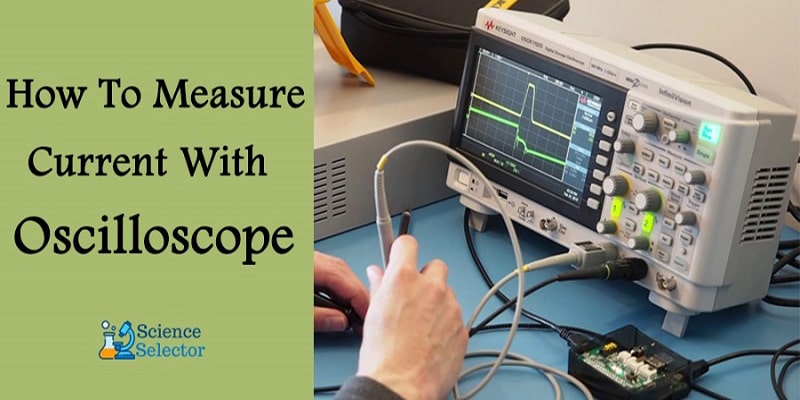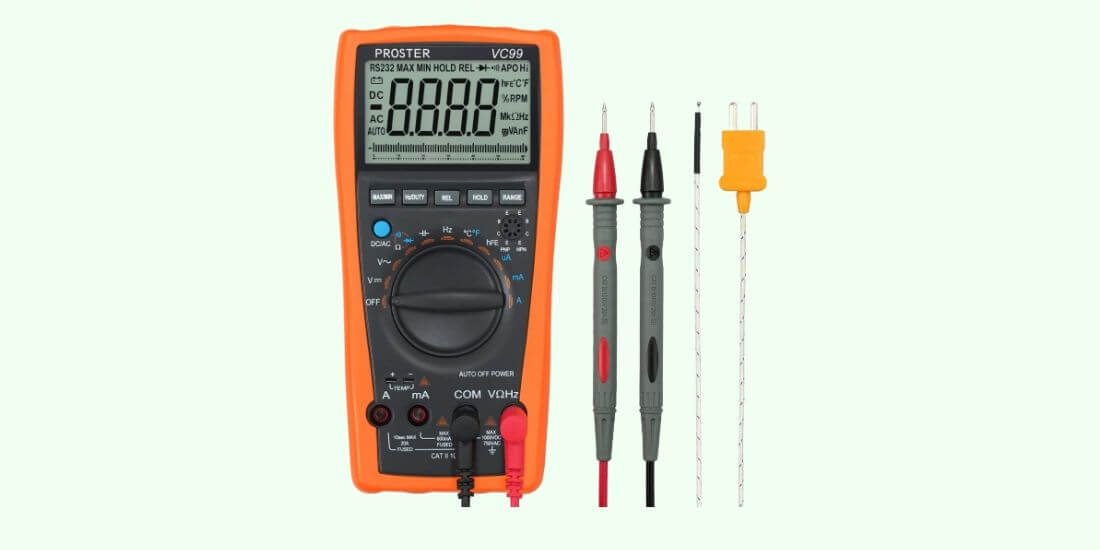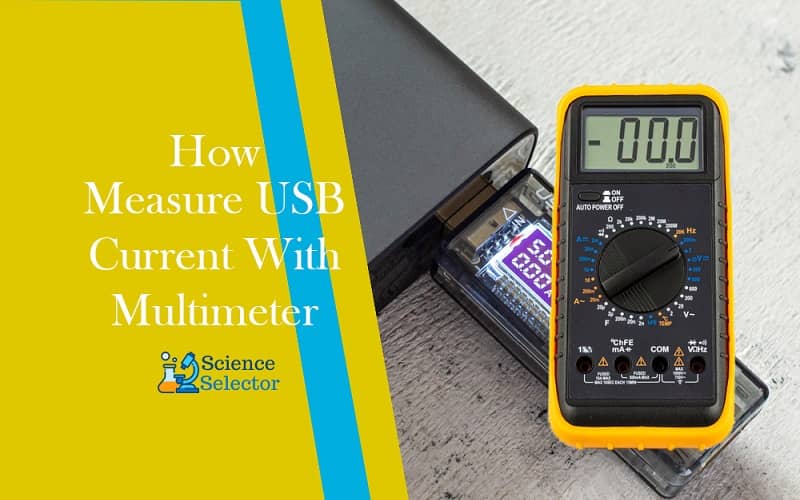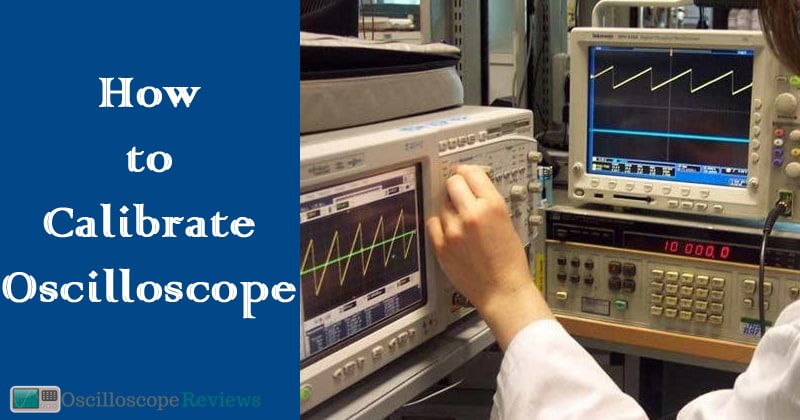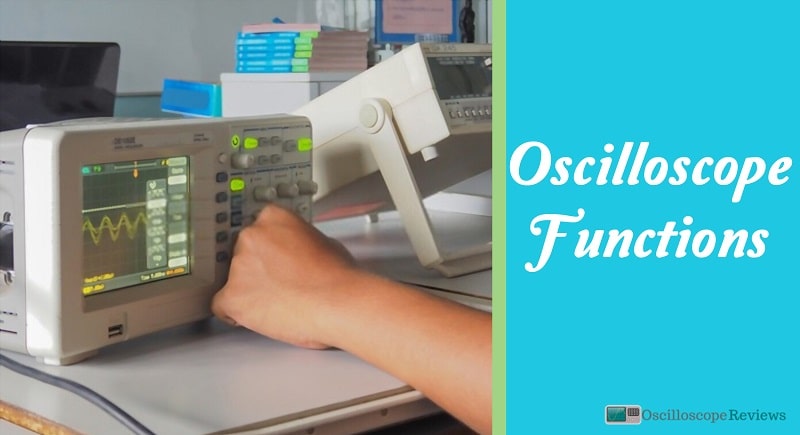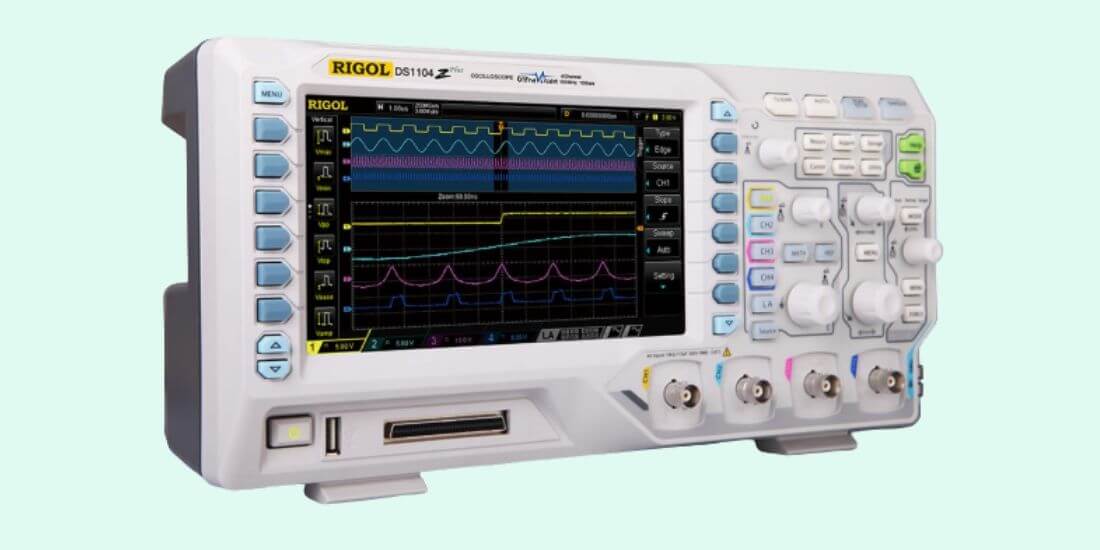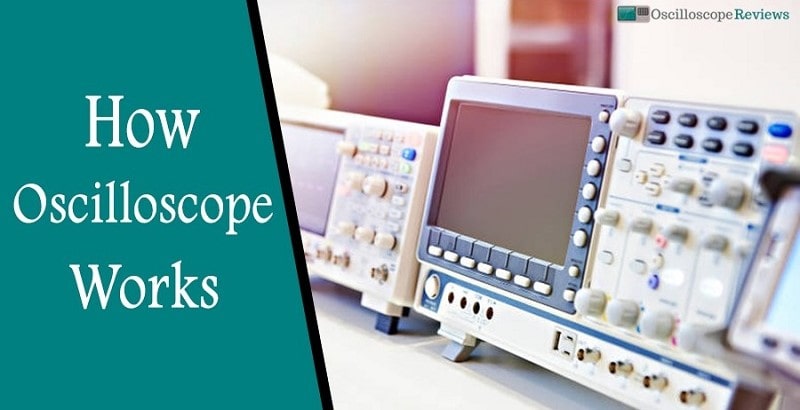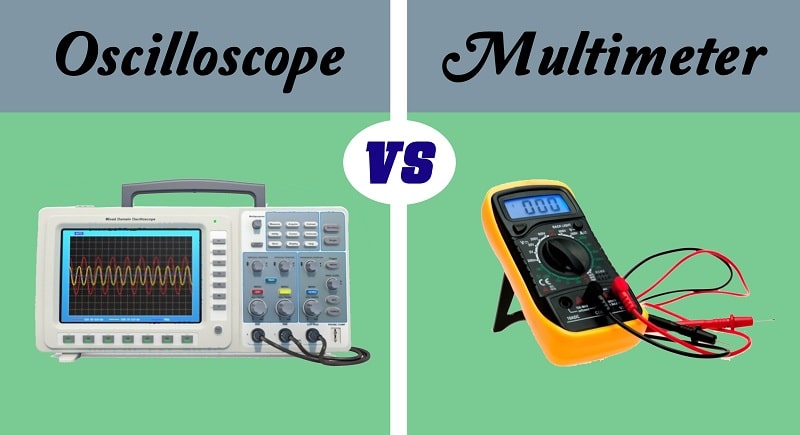Although oscilloscopes are devices typically used for voltage measurements, not many people know that you can also use this to measure current.
Of course, the first measuring tool of choice for taking precise measurements of electric current would certainly be the ammeter, a specialized device that can give you accurate readings for both direct and alternating current.
Alternatively, you could also use a multimeter.
In this article, we’re going to explain how to measure current with an oscilloscope.
There are several methods of doing this, and as you will see, all of them are fairly easy to follow, so you won’t need to be an electrical engineer to do it.
Now, before we get into more detail about how to measure current with oscilloscope, we’ll explain briefly what oscilloscopes are and how Ohm’s law works. (Because you’ll need it to do the measurement.)
How To Measure Current With Oscilloscope
These devices are probably the best option for the sorts of professionals or private individuals who need to measure voltage, electric current, and resistance of a certain electrical circuit or one or more of its parts.
That said, if you don’t have these contraptions available, you can also use an oscilloscope to figure out what the value of electrical current is in a circuit. Although this is not its primary purpose, if you know the science behind how voltage, current, and resistance work with each other, so to speak, you can figure out what each of these values is even with a device such as an oscilloscope.
While the accuracy of such readings may not be as great as if you were to use some of the more suitable measuring tools such as the aforementioned ammeter, for example, (when current is in question), you can still get a reading you can work with – especially if great accuracy is not that important for the measurement you’re taking.
The Main Purpose of Oscilloscopes
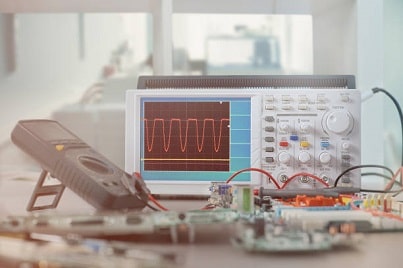
As we stated above, an oscilloscope’s main purpose is not to measure current.
Rather, it’s to measure the voltage between two ends and then display the results on a screen so that you can have a clear visual representation of these values.
To be more precise, oscilloscopes measure the voltage between two points and record the fluctuations of voltage within a certain period. This is why these measuring tools have large screens with a sort of a grid where you can physically measure the voltage fluctuations easily.
So, the important thing to pay attention to with oscilloscopes would be the wavelength. This is the visual representation of voltage we are talking about. Once this wavelength is displayed on the screen, you can also get several different measurements related to voltage.
For example, by looking at this wavelength and perhaps doing a couple of equations (although with modern-day oscilloscopes, this isn’t necessary as they come with inbuilt programs that do this for you), you can determine the frequency, amplitude, distortion of the signal, its rise time, time intervals between the high and low signals, and so on.
Originally, the screen grid we mentioned was used to allow the operator to compare the dimensions of the wavelengths to come up with the values needed through various equations.
Nowadays, however, since most oscilloscopes come with smart microchips with programs that do the math for you, the grid is not necessary, but it’s still there to help you understand what’s going on with the voltage in a visual way, so to speak.
(This is especially useful for learning what voltage is and how it behaves between two different points.)
The Ohm’s Law
Representing the essential law in electronics, Ohm’s law dictates how the most basic values of current, voltage, and resistance interact in a circuit.
It wouldn’t be an understatement to say that all the other laws of electronics, as well as different complex equations that involve other components (such as capacitors, transistors, diodes, and many others), are all based on Ohm’s law.
In its essence, Ohm’s law is a pretty straightforward equation – V = IR
V – voltage
R – resistance
I – current
From this equation, we can see what Ohm meant when he stated that: ‘For any circuit, electric current I is directly proportional to the voltage V and inversely proportional to the resistance R.’
Now, the reason why we’re mentioning Ohm’s law here is that, while oscilloscopes don’t measure the current directly, they can be used to measure it indirectly, so to speak.
Since this equation has three different values, if you can figure out two of the three values, you can also know what the third one is – by applying the equation V = IR.
So, for example, here’s how this works in practice:
If you know that V= 10V and that R=100Ohm, you can flip the equation from above to I=V/R and get the result:
I=10V/100Ohm =0.1Amp or 100mA (milliamps)
This is the equation you’ll be using to figure out the current value when you get the readings of voltage and resistance from an oscilloscope.
Measuring Current Using a Shunt Resistor
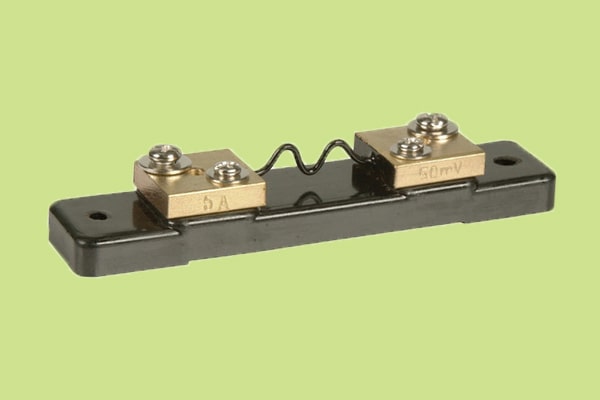
How It Works?
Shunt resistors are a special type of resistor designed to help you measure electric current by comparing the voltage drop that happens due to current passing through the resistor itself.
So, we know the value of resistance because we know how much resistance the shunt resistor has. Also, we know the value of the voltage drops that happens when this resistor is placed in a circuit. Now that you have two values figuring out the value of electrical current is as simple as using the above equation.
In terms of the resistance value, shunt resistors are typically built to have a meager resistance of 0.01 to 0.1 Ω.
(Ω is the Greek letter ‘omega,’ which represents the resistance in Ohm’s.)
The reason behind this is that high resistance causes the voltage value to drop. While this is normal, if the resistance is too high, the drop can be too severe, so to speak, which can cause the entire circuit to shut down.
Of course, higher resistance values can be used with these shunt resistors, and this way, you can get a more precise measurement, but then you risk this big voltage drop, which would then beat the purpose of measuring the first place. (This can be done, but you need to be careful not to place too much resistance in the circuit.)
Shunt resistors are often used for this purpose because they are fairly easy to set up and can be used to measure both direct and alternating currents.
How to Set up an Oscilloscope Using this Method?
Now that we know Ohm’s law and how to measure current with oscilloscope by using it, it’s also important to get a clearer idea of connecting a circuit with a shunt resistor in it with your oscilloscope.
While this may look like a simple enough procedure on the surface, there typically emerges a problem when it comes to some of the modern-day oscilloscopes. Namely, in most modern oscilloscopes, the ground clip is directly connected to the earth’s ground, so you cannot traditionally introduce another circuit.
(Connecting the ground clip to either side of a shunt resistor will inevitably cause a short circuit.)
So, what you can do to bypass this would be to connect the ground clip from the oscilloscope to the circuit’s ground and move the shunt resistor to the return side. (This is also known as the low-side shunt resistor.)
This way, you can avoid a short circuit, but this will cause a different sort of problem that you’ll also need to take care of. Namely, connecting the ground clip of the oscilloscope to the ground of the measuring circuit will create something called a ground loop.
In such a setup, the circuit circulates from earth ground through the entire circuit, the oscilloscope, and then back to earth. This process then repeats itself indefinitely, which creates the loop.
A ground loop won’t cause a short circuit; it can hamper the accuracy of your measurement to a degree.
Of course, you can only encounter this problem if you’re using an oscilloscope that’s powered from the wall socket. In case you’re using a battery-powered oscilloscope, you won’t have to worry about this problem.
Disadvantages of The Shunt Resistor Method
While shunt resistors are fairly easy to use and set up, there are a couple of disadvantages to measuring current. To more precise, there are two potential problems that you need to take into consideration before you opt for this method of current measurement:
1) First, shunt resistors tend to have a rather large tolerance range of up to 5%.
So, if you need to do some simple measurements for a school project, this tolerance won’t be that much of a problem.
On the other hand, if you are working on a more serious project or need an exact measurement for some other reason, you might need to use some other method to figure out the value of the current.
(Using a multimeter or ammeter would probably be the best option.)
2) The second disadvantage would have to do with the inevitable heating of the resistor. Pretty much all resistors tend to heat up over time.
Although this is a completely natural occurrence, the problem stems from the fact that increased heat means the resistor will gain even more resistance than its initial value. This can not only lead to inaccurate readings but can also destroy the resistor and break the circuit.
Measuring Current Using a Probe
The second way of how to measure current with oscilloscope is a fairly simple one, but you will need specialized current probes to do the job.
These probes are easy to use as you need to plug them in the oscilloscope, and they are ready to go. The majority of modern-day current probes have a clamp-style way of ‘attaching’ to the circuit you’re trying to measure, so if you have a newer model of these probes, you won’t have to deal with exposed wires.
All you need to do is ‘clamp’ the end of the probe around the wire in which you want to check the current, and the results will be immediately available to you on the screen of your oscilloscope.
The great thing about this method is that you don’t need to do any equations (although they are not that difficult to figure out, as you’ve seen above), as you will get an accurate measurement on the screen as soon as you clamp the end of the probe onto a circuit wire.
There are two major types of current probes:
1) The ones that come with a semi-circular ferrite core, and
2) The ones that use a special Hall sensor that is placed between two ferrite semicircles.
Both of these systems work on roughly the same principle.
The ferrite core inside the clamp produces a magnetic field when it comes close to the wire it’s been clamped around. This magnetic field then creates a voltage in the coil that’s around the ferrite core.
The trick is that the value of the voltage is proportional to the value of the current that’s ‘causing’ it.
For the record, it may seem obvious that how to measure current with oscilloscope is an easier way to get a measurement, but many people are turned off from this approach because these probes tend to be quite expensive.
Conclusion
All in all, whether you fancy using a current probe to get your measurement or you are fine to do a little bit of circuit-building to do it the old-fashioned way, measuring current with an oscilloscope is not only doable but also fairly easy. We hope you found how to measure current with an oscilloscope; this article helped you figure out how to do this, and we wish you no short circuits and plenty of success taking these measurements.
-
Oscilloscopes are machines that measure and show voltage signals over a period of time. They…
-
On devices, the current strength that they can withstand is rarely indicated. The main ones…
-
Oscilloscopes are a must-have for any electronics workbench. But how do you calibrate an oscilloscope?…
-
DIY electronic projects are great and enjoyable. As a beginner, you can be a little…
-
An oscilloscope is a device that captures a live signal from a test circuit and…
-
Oscilloscopes are instruments used in the laboratory which is used to analyze waves of electronic…
-
It is almost certain that you have drawn charts in your life or seen them…
-
Electricity is one of the fantastic inventions made over the past few centuries and has…

